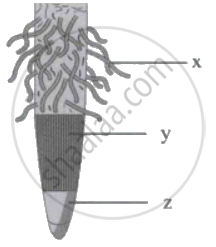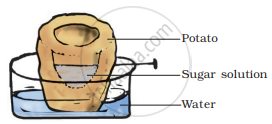Advertisements
Advertisements
Question
Mention whether the following statement is true (T) or false (F) and give an explanation in support of your answer.
If the phloem of a twig is removed keeping the xylem intact, the leaves of a twig wilt.
Options
True
False
Solution
This statement is false.
Explanation:
The leaves of the twig remain turgid since its xylem is intact and xylem is responsible for water conduction in plants.
APPEARS IN
RELATED QUESTIONS
Which one of the following is a characteristic NOT related with the suitability of the roots for absorbing water?
The diagram given below represents the results of an experiment conducted on two freshly taken leafy shoots of a herbaceous plant. The lower ends of the shoots dip in ordinary water.
(i) What is the aim of the experiment?
(ii) Some parts of the stem in both the shoots have been removed. Name the conducting tissue in shoot (a) and in shoot (b) that has been removed.
(iii) What are the results of this experiment?

Choose the correct answer:
Wilting of plants occurs when ____________
Given below is an experimental demonstration.

(i) Which phenomenon has been demonstrated in the given figure?
(ii) What is the solute and what is solvent in the above experiment?
(iii) Define the phenomenon in Q. (i) above.
(iv) Give one example from your daily life experiences based on this principle.
Explain the Term: Guttation
Which part of the root helps in the maximum absorption of water and minerals?
Identify labels x, y, z in the given figure of root showing different regions.

____________plants like orchids absorb water vapours from air with the help of epiphytic roots having special tissue called velamen.
Which plant does tissue transport water and minerals from the roots to the leaf?
Look at Figure 11.1. Draw another figure of the same set-up as would be observed after a few hours.

